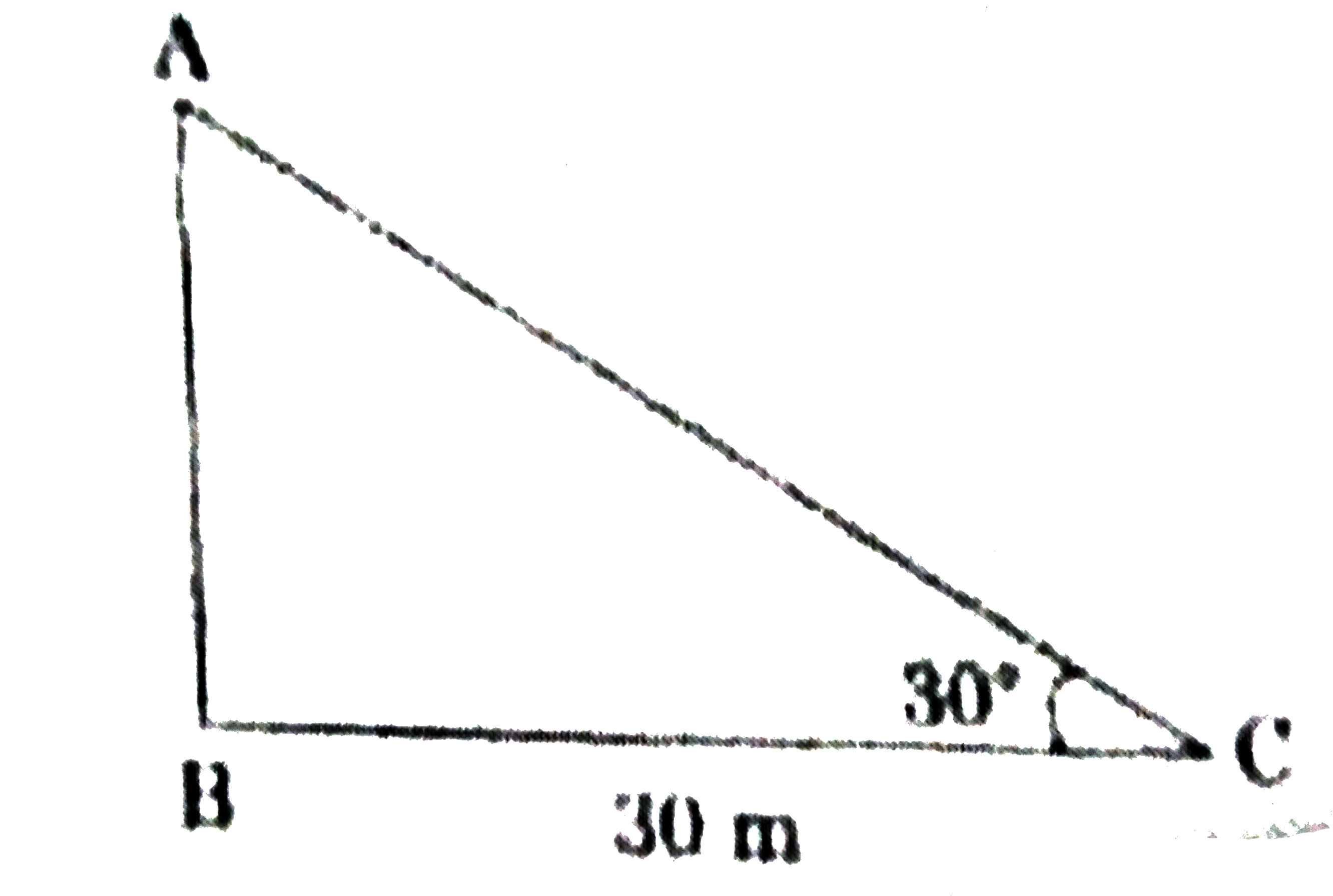An observer finds that the elevation of the top of a tower is 22.5∘ and after walking100 m towards the foot of the tower, he finds that the elevation of the top has increased to 67.5∘. The height of the tower in metres is:
50
75
125
175
The correct Answer is:A
To solve the problem, we will use trigonometric principles, specifically the tangent function, which relates the angles of elevation to the height of the tower and the distances involved.
1. Understanding the Problem:
- Let the height of the tower be h meters.
- The observer is initially at point C and sees the top of the tower at an angle of elevation of 22.5∘.
- After walking 100 meters towards the tower, he reaches point D and sees the top at an angle of elevation of 67.5∘.
2. Setting Up the Diagram:
- Let AB be the tower, C the initial position of the observer, and D the position after walking 100 meters.
- Let BC be the distance from the observer to the foot of the tower initially, and BD be the distance from the foot of the tower to point D (which is 100 m).
3. Using the Tangent Function:
- From triangle ABC (the larger triangle), we have:
tan(22.5∘)=hBC
Therefore,
h=BC⋅tan(22.5∘)(Equation 1)
- From triangle ABD (the smaller triangle), we have:
tan(67.5∘)=hBC−100
Therefore,
h=(BC−100)⋅tan(67.5∘)(Equation 2)
4. Substituting Values of Tangent:
- We know:
tan(22.5∘)=√2−1
tan(67.5∘)=√2+1
- Substituting these values into the equations:
- From Equation 1:
h=BC⋅(√2−1)(Equation 1)
- From Equation 2:
h=(BC−100)⋅(√2+1)(Equation 2)
5. Equating the Two Expressions for h:
BC⋅(√2−1)=(BC−100)⋅(√2+1)
6. Expanding and Rearranging:
BC(√2−1)=BC(√2+1)−100(√2+1)
BC(√2−1−√2−1)=−100(√2+1)
BC(−2)=−100(√2+1)
BC=100(√2+1)2=50(√2+1)
7. Finding the Height h:
- Substitute BC back into Equation 1:
h=50(√2+1)(√2−1)
- Using the difference of squares:
h=50((√2)2−12)=50(2−1)=50 meters
Final Answer:
The height of the tower is 50 meters.
- Let the height of the tower be h meters.
- The observer is initially at point C and sees the top of the tower at an angle of elevation of 22.5∘.
- After walking 100 meters towards the tower, he reaches point D and sees the top at an angle of elevation of 67.5∘.
- Let AB be the tower, C the initial position of the observer, and D the position after walking 100 meters.
- Let BC be the distance from the observer to the foot of the tower initially, and BD be the distance from the foot of the tower to point D (which is 100 m).
- From triangle ABC (the larger triangle), we have:
tan(22.5∘)=hBC
Therefore,
h=BC⋅tan(22.5∘)(Equation 1)
tan(67.5∘)=hBC−100
Therefore,
h=(BC−100)⋅tan(67.5∘)(Equation 2)
- We know:
tan(22.5∘)=√2−1
tan(67.5∘)=√2+1
- Substituting these values into the equations:
- From Equation 1:
h=BC⋅(√2−1)(Equation 1)
- From Equation 2:
h=(BC−100)⋅(√2+1)(Equation 2)
BC⋅(√2−1)=(BC−100)⋅(√2+1)
BC(√2−1)=BC(√2+1)−100(√2+1)
BC(√2−1−√2−1)=−100(√2+1)
BC(−2)=−100(√2+1)
BC=100(√2+1)2=50(√2+1)
- Substitute BC back into Equation 1:
h=50(√2+1)(√2−1)
- Using the difference of squares:
h=50((√2)2−12)=50(2−1)=50 meters
The height of the tower is 50 meters.
Topper's Solved these Questions
- BOOK - OBJECTIVE RD SHARMA ENGLISHCHAPTER - HEIGHTS AND DISTANCESEXERCISE - Exercise45videos
HEIGHTS AND DISTANCES
- BOOK - OBJECTIVE RD SHARMA ENGLISHCHAPTER - EXPONENTIAL AND LOGARITHMIC SERIESEXERCISE - Chapter Test20videos
EXPONENTIAL AND LOGARITHMIC SERIES
- BOOK - OBJECTIVE RD SHARMA ENGLISHCHAPTER - INCREASING AND DECREASING FUNCTIONSEXERCISE - Chapter Test18videos
INCREASING AND DECREASING FUNCTIONS
Similar Questions
A person observed the angle of elevation of the top of a tower as 30∘ . He walked 50m towards the foot of the tower along level ground and found the angle of elevation of the top of the tower as 60∘ . Find the height of the tower.
View SolutionThe angle of elevation of the top of a tower from a certain point is 30o . If the observer moves 20 m towards the tower, the angle of elevation of the top of the tower increases by 15o . Then height of the tower is
View SolutionThe angle of elevation of the top of a tower from a point on the ground is 30∘. After walking 45 m towards the tower, the angle of elevation becomes 45∘. Find the height of the tower.
View SolutionThe angle of elevation of a tower from a point on the same level as the foot of the tower is 300. On advancing 150 metres towards the foot of the tower, the angle of elevation of the tower becomes 600. Show that the height of the tower is 129.9 metres (Use √3=1.732 ).
View SolutionThe angle of elevation of the top of a tower from a point on the ground is 30∘. After walking 40√3 m towards the tower, the angle of elevation becomes 60∘. Find the height of the tower.
View SolutionA person standing on the ground observes the angle of elevation of the top of a tower to be 30∘ On walking a distance a in a certain direction, he finds the elevation of the top to be same as before. He then walks a distance 53a at right angles to his former direction, and finds that the elevation of the top has doubled. The height of the tower is
View SolutionThe angle elevation of the top of a tower from a point C on the ground. Which is 30 m away from the foot of the tower is 30∘ . Find the height of the tower.
 View Solution
View SolutionThe angle of elevation of the top of a tower from a point on the ground, which is 30m away from the foot of the tower is 30∘ . Find the height of the tower.
View SolutionThe angle of elevation of the top of a tower from a point on the ground, which is 30m away from the foot of the tower, is 30∘. Find the height of the tower.
View SolutionThe angle of elevation of the top of a tower from a point on the ground, which is 30 m away from the foot of the tower is 30∘. Find the height of the tower.
View Solution
